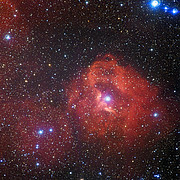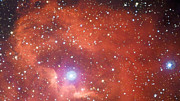Pressemitteilung
Eine Studie in Scharlachrot
16. April 2014
Diese neue Aufnahme vom La-Silla-Observatorium in Chile gibt den Blick auf eine Wasserstoffwolke namens Gum 41 frei. In der Mitte des wenig bekannten Nebels geben leuchtkräftige heiße junge Sterne energiereiche Strahlung ab, die den Wasserstoff in der Umgebung dazu bringt in einem charakteristischen roten Farbton zu leuchten.
Diese Himmelsregion im Sternbild Centaurus (der Zentaur) beherbergt viele helle Nebel, die zu heißen neugeborenen Sternen gehören, die aus Wasserstoffgaswolken entstanden sind. Die intensive Strahlung der jungen Sterne regt den verbliebenen Wasserstoff um sie herum an und bringt so das Gas in einem bestimmten Rotton zum Leuchten, der typisch für Sternentstehungsregionen ist. Ein anderes bekanntes Beispiel dieses Phänomens ist der Lagunennebel (eso0936), eine riesige Wolke mit ähnlich hellen Rottönen.
Der Nebel in diesem Bild befindet sich etwa 7300 Lichtjahre von der Erde entfernt. Der australische Astronom Colin Gum entdeckte ihn auf einer Fotografie, die am Mount Stromlo-Observatorium in der Nähe von Canberra aufgenommen wurde und fügte sie zu seinem Katalog von 84 Emissionsnebeln hinzu, der 1955 veröffentlicht wurde. Gum 41 ist eigentlich ein kleiner Teil eines größeren Objekts mit dem Namen Lambda Centauri-Nebel, der im Englischen auch unter dem exotischeren Namen Running Chicken Nebula bekannt ist (von dem ein anderer Teil Gegenstand von eso1135 war). Gum starb im jungen Alter in einem Skiunfall in der Schweiz im Jahr 1960.
In dieser Aufnahme von Gum 41 erscheinen die Wolken ziemlich dicht und hell, was aber ein Trugschluss ist. Wenn ein hypothetischer Raumfahrer durch diesen Nebel fliegen würde, ist es wahrscheinlich, dass er ihn gar nicht bemerken würde, denn – sogar aus der Nähe – wäre er zu lichtschwach um vom menschlichen Auge wahrgenommen zu werden. Dies erklärt auch, warum dieses große Objekt bis zur Mitte des zwanzigsten Jahrhunderts auf seine Entdeckung warten musste – sein Licht ist stark ausgedünnt und das rote Leuchten ist im visuellen Bereich schlecht sichtbar.
Dieses neue Portrait von Gum 41 – wahrscheinlich eines der bisher besten von diesem schwer fassbaren Objekt – wurde aus Daten des Wide Field Imager (WFI) am MPG/ESO 2,2-Meter-Teleskop am La-Silla-Observatorium in Chile erstellt. Es ist eine Kombination von Bildern, die durch einen Blau-, Rot- und Grünfilter aufgenommen wurden, zusammen mit Aufnahmen mit Hilfe eines speziellen Filters, der dafür entwickelt wurde das rote Leuchten von Wasserstoff herauszufiltern.
Weitere Informationen
Die Europäische Südsternwarte ESO (European Southern Observatory) ist die führende europäische Organisation für astronomische Forschung und das wissenschaftlich produktivste Observatorium der Welt. Getragen wird die Organisation durch ihre 15 Mitgliedsländer: Belgien, Brasilien, Dänemark, Deutschland, Finnland, Frankreich, Großbritannien, Italien, die Niederlande, Österreich, Portugal, Spanien, Schweden, die Schweiz und die Tschechische Republik. Die ESO ermöglicht astronomische Spitzenforschung, indem sie leistungsfähige bodengebundene Teleskope entwirft, konstruiert und betreibt. Auch bei der Förderung internationaler Zusammenarbeit auf dem Gebiet der Astronomie spielt die Organisation eine maßgebliche Rolle. Die ESO betreibt drei weltweit einzigartige Beobachtungsstandorte in Nordchile: La Silla, Paranal und Chajnantor. Auf dem Paranal betreibt die ESO mit dem Very Large Telescope (VLT) das weltweit leistungsfähigste Observatorium für Beobachtungen im Bereich des sichtbaren Lichts und zwei Teleskope für Himmelsdurchmusterungen: VISTA, das größte Durchmusterungsteleskop der Welt, arbeitet im Infraroten, während das VLT Survey Telescope (VST) für Himmelsdurchmusterungen ausschließlich im sichtbaren Licht konzipiert ist. Die ESO ist der europäische Partner bei den neuartigen Teleskopverbund ALMA, dem größten astronomischen Projekt überhaupt. Derzeit entwickelt die ESO ein Großteleskop mit 39 Metern Durchmesser für Beobachtungen im Bereich des sichtbaren und Infrarotlichts, das einmal das größte optische Teleskop der Welt werden wird: das European Extremely Large Telescope (E-ELT).
Die Übersetzungen von englischsprachigen ESO-Pressemitteilungen sind ein Service des ESO Science Outreach Network (ESON), eines internationalen Netzwerks für astronomische Öffentlichkeitsarbeit, in dem Wissenschaftler und Wissenschaftskommunikatoren aus allen ESO-Mitgliedsländern (und einigen weiteren Staaten) vertreten sind. Deutscher Knoten des Netzwerks ist das Haus der Astronomie in Heidelberg.
Links
- Fotos vom MPG/ESO 2,2-Meter-Teleskop
- Fotos aufgenommen mit dem MPG/ESO 2,2-Meter-Teleskop
- Fotos von La Silla
Kontaktinformationen
Richard Hook
ESO Public Information Officer
Garching bei München, Germany
Tel: +49 89 3200 6655
Mobil: +49 151 1537 3591
E-Mail: rhook@eso.org
Markus Nielbock (Pressekontakt Deutschland)
ESO Science Outreach Network
und Haus der Astronomie
Heidelberg, Deutschland
Tel: +49 6221 528-134
E-Mail: eson-germany@eso.org
Über die Pressemitteilung
| Pressemitteilung Nr.: | eso1413de |
| Name: | Gum 41 |
| Typ: | Milky Way : Nebula : Type : Star Formation |
| Facility: | MPG/ESO 2.2-metre telescope |
| Instruments: | WFI |
Our use of Cookies
We use cookies that are essential for accessing our websites and using our services. We also use cookies to analyse, measure and improve our websites’ performance, to enable content sharing via social media and to display media content hosted on third-party platforms.
ESO Cookies Policy
The European Organisation for Astronomical Research in the Southern Hemisphere (ESO) is the pre-eminent intergovernmental science and technology organisation in astronomy. It carries out an ambitious programme focused on the design, construction and operation of powerful ground-based observing facilities for astronomy.
This Cookies Policy is intended to provide clarity by outlining the cookies used on the ESO public websites, their functions, the options you have for controlling them, and the ways you can contact us for additional details.
What are cookies?
Cookies are small pieces of data stored on your device by websites you visit. They serve various purposes, such as remembering login credentials and preferences and enhance your browsing experience.
Categories of cookies we use
Essential cookies (always active): These cookies are strictly necessary for the proper functioning of our website. Without these cookies, the website cannot operate correctly, and certain services, such as logging in or accessing secure areas, may not be available; because they are essential for the website’s operation, they cannot be disabled.
Functional Cookies: These cookies enhance your browsing experience by enabling additional features and personalization, such as remembering your preferences and settings. While not strictly necessary for the website to function, they improve usability and convenience; these cookies are only placed if you provide your consent.
Analytics cookies: These cookies collect information about how visitors interact with our website, such as which pages are visited most often and how users navigate the site. This data helps us improve website performance, optimize content, and enhance the user experience; these cookies are only placed if you provide your consent. We use the following analytics cookies.
Matomo Cookies:
This website uses Matomo (formerly Piwik), an open source software which enables the statistical analysis of website visits. Matomo uses cookies (text files) which are saved on your computer and which allow us to analyze how you use our website. The website user information generated by the cookies will only be saved on the servers of our IT Department. We use this information to analyze www.eso.org visits and to prepare reports on website activities. These data will not be disclosed to third parties.
On behalf of ESO, Matomo will use this information for the purpose of evaluating your use of the website, compiling reports on website activity and providing other services relating to website activity and internet usage.
Matomo cookies settings:
Additional Third-party cookies on ESO websites: some of our pages display content from external providers, e.g. YouTube.
Such third-party services are outside of ESO control and may, at any time, change their terms of service, use of cookies, etc.
YouTube: Some videos on the ESO website are embedded from ESO’s official YouTube channel. We have enabled YouTube’s privacy-enhanced mode, meaning that no cookies are set unless the user actively clicks on the video to play it. Additionally, in this mode, YouTube does not store any personally identifiable cookie data for embedded video playbacks. For more details, please refer to YouTube’s embedding videos information page.
Cookies can also be classified based on the following elements.
Regarding the domain, there are:
- First-party cookies, set by the website you are currently visiting. They are stored by the same domain that you are browsing and are used to enhance your experience on that site;
- Third-party cookies, set by a domain other than the one you are currently visiting.
As for their duration, cookies can be:
- Browser-session cookies, which are deleted when the user closes the browser;
- Stored cookies, which stay on the user's device for a predetermined period of time.
How to manage cookies
Cookie settings: You can modify your cookie choices for the ESO webpages at any time by clicking on the link Cookie settings at the bottom of any page.
In your browser: If you wish to delete cookies or instruct your browser to delete or block cookies by default, please visit the help pages of your browser:
Please be aware that if you delete or decline cookies, certain functionalities of our website may be not be available and your browsing experience may be affected.
You can set most browsers to prevent any cookies being placed on your device, but you may then have to manually adjust some preferences every time you visit a site/page. And some services and functionalities may not work properly at all (e.g. profile logging-in, shop check out).
Updates to the ESO Cookies Policy
The ESO Cookies Policy may be subject to future updates, which will be made available on this page.
Additional information
For any queries related to cookies, please contact: pdprATesoDOTorg.
As ESO public webpages are managed by our Department of Communication, your questions will be dealt with the support of the said Department.





